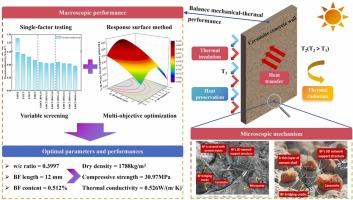玄武岩纤维增强陶粒混凝土的力学强度与保温隔热平衡:微观机理分析与多目标优化
IF 8
1区 工程技术
Q1 CONSTRUCTION & BUILDING TECHNOLOGY
引用次数: 0
摘要
在全球推进低碳建筑的努力中,陶粒混凝土因其优异的保温性能而成为一种有前途的可持续材料。然而,在陶粒混凝土中实现机械强度和热性能之间的最佳平衡仍然是节能建筑应用的关键挑战。本研究通过单因素试验和响应面法(RSM)研究了水灰比(w/c)、玄武岩纤维(BF)长度和BF含量对玄武岩纤维增强陶粒混凝土(BFRCC)力学热性能的影响。结果表明,将w/c比提高到0.4,添加12 mm BF (vol% 0.4 ),BFRCC的导热系数降低到0.519 w/ (m·K),同时LC30强度保持在34.65 MPa。结合汞侵入孔隙度测定(MIP)、扫描电子显微镜(SEM)和能量色散x射线能谱(EDS)来阐明控制多尺度结构-热关系的潜在机制。微观结构表征分析表明,由“纤维-陶粒-水泥基体”组成的坚固的三维互锁框架有效地在基体内部分布应力,减缓裂纹扩展,细化孔隙结构,阻碍传热途径。RSM优化确定了最佳参数:w/c = 0.3997,BF长度= 12 mm, BF含量= 0.512 vol%。实验验证了该模型具有较高的预测精度(相对误差<;5 %)。这些发现为设计结构和热集成陶粒混凝土以促进可持续建筑提供了实用指导。本文章由计算机程序翻译,如有差异,请以英文原文为准。

Balancing mechanical strength and thermal insulation in basalt fiber-reinforced ceramsite concrete (BFRCC): Microscopic mechanism analysis and multi-objective optimization
In the global effort to advance low-carbon construction, ceramsite concrete has emerged as a promising sustainable material due to its excellent thermal insulation properties. However, achieving an optimal balance between mechanical strength and thermal performance in ceramsite concrete remains a critical challenge for energy-efficient building applications. This study examines the effects of water-cement (w/c) ratios, basalt fiber (BF) length, and BF content on the mechanical-thermal properties of basalt fiber-reinforced ceramsite concrete (BFRCC) by single-factor experiments and response surface methodology (RSM). Results indicate that increasing the w/c ratio to 0.4 and incorporating 12 mm BF at 0.4 vol% reduces BFRCC's thermal conductivity to 0.519 W/(m·K) while maintaining LC30 strength at 34.65 MPa. Mercury intrusion porosimetry (MIP), scanning electron microscopy (SEM), and energy-dispersive X-ray spectroscopy (EDS) were combined to elucidate the underlying mechanisms governing multiscale structural-thermal relationships. Microstructural characterization analysis indicates that a robust three-dimensional interlocking framework composed of "fiber-ceramsite-cement matrix" effectively distributes stress within the matrix, slows crack propagation, and refines pore structures to impede heat transfer pathways. Additionally, RSM optimization identified optimal parameters: w/c ratio = 0.3997, BF length = 12 mm, and BF content = 0.512 vol%. Experimental validation confirmed the model’s high predictive accuracy (relative error <5 %). These findings offer practical guidance for designing structurally and thermally integrated ceramsite concrete mixes to advance sustainable construction.
求助全文
通过发布文献求助,成功后即可免费获取论文全文。
去求助
来源期刊

Construction and Building Materials
工程技术-材料科学:综合
CiteScore
13.80
自引率
21.60%
发文量
3632
审稿时长
82 days
期刊介绍:
Construction and Building Materials offers an international platform for sharing innovative and original research and development in the realm of construction and building materials, along with their practical applications in new projects and repair practices. The journal publishes a diverse array of pioneering research and application papers, detailing laboratory investigations and, to a limited extent, numerical analyses or reports on full-scale projects. Multi-part papers are discouraged.
Additionally, Construction and Building Materials features comprehensive case studies and insightful review articles that contribute to new insights in the field. Our focus is on papers related to construction materials, excluding those on structural engineering, geotechnics, and unbound highway layers. Covered materials and technologies encompass cement, concrete reinforcement, bricks and mortars, additives, corrosion technology, ceramics, timber, steel, polymers, glass fibers, recycled materials, bamboo, rammed earth, non-conventional building materials, bituminous materials, and applications in railway materials.
 求助内容:
求助内容: 应助结果提醒方式:
应助结果提醒方式:


